Bichir fish is a family of freshwater fishes with ray fins that are native to the continent of Africa where they are well spread out in different parts. There are up to 14 genera of the fish that are known currently all of which are evenly spread out in Africa. The fish are known to inhabit freshwater basins in Africa and parts of the Indian sub-continent. The fish in the wild prefers muddy water with a bottom that is silted but sometimes it even lives in bogs.
Table of Contents
Bichir: A Quick Summary
Bichir, also known as reedfish or dinosaur eel, is a group of elongated, predatory fish native to Africa. They are popular in the aquarium trade due to their unusual appearance and hardy nature. Bichir are generally peaceful, but they may eat smaller tank mates.
Bichir Overview
There are just various species of bichir that will survive in tank conditions such as the ornate bichir, Senegal bichir, barred bichir, and marbled bichir. The fish has rather poor eyesight but a very strong sense of smell that it uses to navigate the waters that it inhabits in the wild.
Bichir Care
Considering the level of the hardiness of Bichirs, these exotic Bichirs are very easy to keep healthy and happy. But for that, you will have to make sure that you have the correct tools and information. These creatures are listed as nocturnal carnivores, and they are from the Congo River’s shallow and muddy waters. They prefer to breed during rain seasons and eat at night.
Some studies have suggested that Bichirs are peaceful for different predatory fish species and can be a perfect companion for other peaceable and medium-sized species. In terms of feeding, you can offer pellets to supplement a mixed diet of living and frozen prey, but that should not be the only source for consistent nutrition. Another interesting thing that you should consider if you plan to keep Bichir is that they are great escape artists. As they need a sufficient amount of atmospheric oxygen to survive, you should offer sufficient space above the surface to let them breathe properly. But take care of the small openings near the lid as they can come out of the tank that way.
Appearance of Bichir Fish

The body of the fish is long looking almost similar to that of an eel and it has unique dorsal finlets. The scales of the fish are diamond-shaped and a close look at them reveals to you that they are flexibly joined together. The body of the fish is very strong and it is interesting that the fish can still breathe even when out of the water.
There are 12 different species of Bichirs, and all of them share some similar characteristics. They all have a snake-like body and have multiple fins and dorsal spines. Well, their eyesight is low, and to overcome this issue, they come with protruding nostrils that can help them identify their foods by pinpointing the smell’s source.
Even though you will not find many differential factors among the females and males, female Bichirs are larger than the males. On the other hand, males come with thicker and wider dorsal and anal fins.
Types of Bichir
Some of the common types of Bichir are:
The Dinosaur Bichir
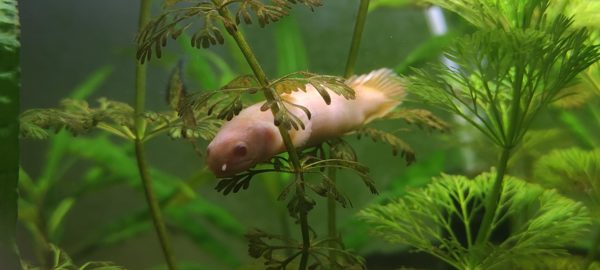
They are also known as the Gray or Senegal Bichir. They are the smallest species and can grow around 14-inches in length. It has a long and cylindrical body, and it looks grayish. Besides, these Bichirs have larger pectoral fins and serrated dorsal fins to swim. They are also available in pink, blue, and white shades.
The Ornate Bichir
The scientific name of the Ornate Bichir is Polypterus ornatipinnis. They have yellow pattern colorings on their back section, fins, head, and body. The base colors in these species may range from gray to dark brown. The Ornate Bichirs are very popular and can grow around 24-inches under a good living environment.
The Delhezi Bichir
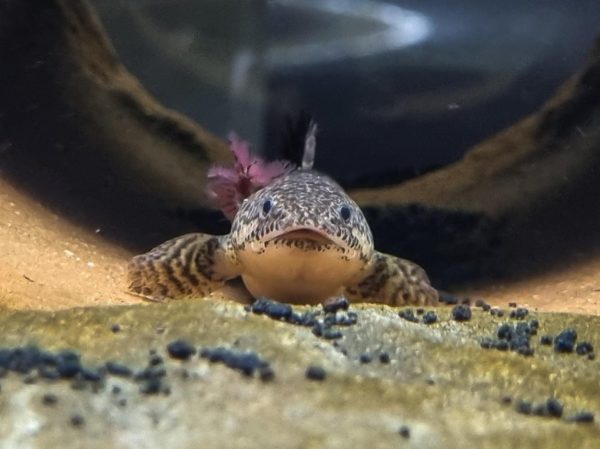
They are called Polypterus delhezi and have a gray coloration, and you can find bright yellow or green sports on the body. They are quite popular among aquaretic for their unique coloration.
The Saddled Bichir
Known as Polypterus Endlicheri, these are the largest species and reach 30 to 25 inches. Their lower jaw is much longer than their upper jaw, making them different from others. Speaking about the color, they look whitish-yellow, and there are dark bands on the body.
The Albino Bichir
They are the Albino variety of this species. With red eyes, they come with a white-colored body.
Bichir Temperament And Behavior
One of the most important things that you should keep in mind when taking good care of Bichir fish is their behavior and temperament. Even though they are not considered aggressive fish, they do have little aggressive tendencies that every aquarist should manage.
Considering that Bichirs are carnivores, it can be concluded that you may face some issues when you keep them with other fish in the same tank. Any fish smaller than their size can be a target for the Bichirs.
Apart from a little aggressive temperament, generally, they are quite active. In general, Bichirs are bottom-dwellers, but they also frequently come to the surface for fresh air. So, they always keep swimming up and down in a tank, making them fun creatures. As they are nocturnal, they remain active during the night.
Keeping the Bichir Fish in Tank
Keeping Bichir in a tank is not complicated and even an aquarium beginner can still set up a tank for keeping the fish successfully. The species of this fish are not demanding at all and as long as the basic tank conditions are maintained it will just do well in captivity. Even in the wild, the fish are capable of inhabiting muddy dirty water due to their enduring nature. It must be noted that the fish is a predator and if you wish to keep it in a community tank better keep it with large fish.
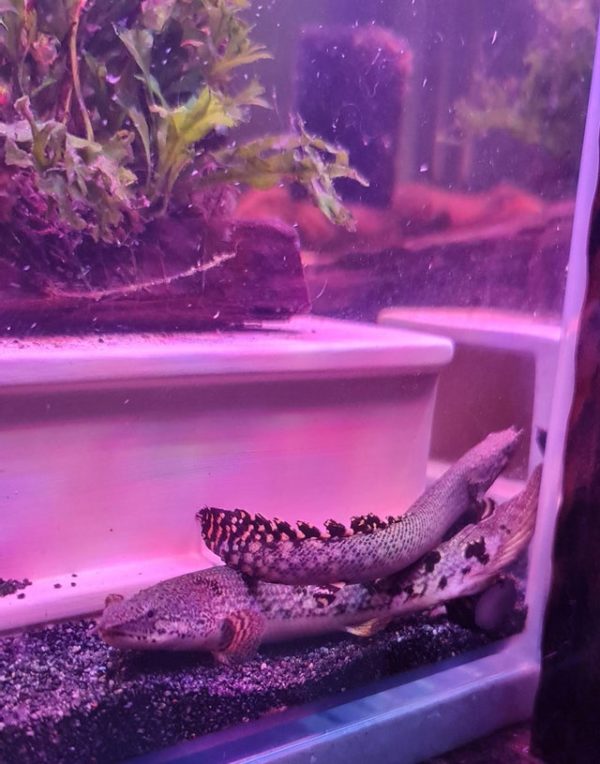
Another thing to keep in mind if you are planning to keep the fish in a community tank with other fish is that it is rather slow in finding its food. This means that if it is housed together with other fish that are fast and swift at eating available food, it might find difficulty feeding well. This, therefore, calls on the aquarist to be keen when administering food to the fish when in a community tank. Ensure that the fish has sufficient food and is not left starving.
Bichir Care & Tank Set-Up
Tank requirements
Because the fish can grow to be very large it is best to give them a big enough tank that will give them ample space for swimming. To keep one Bichir, therefore, you will need to have a tank that is at least 50 gallons or even larger.
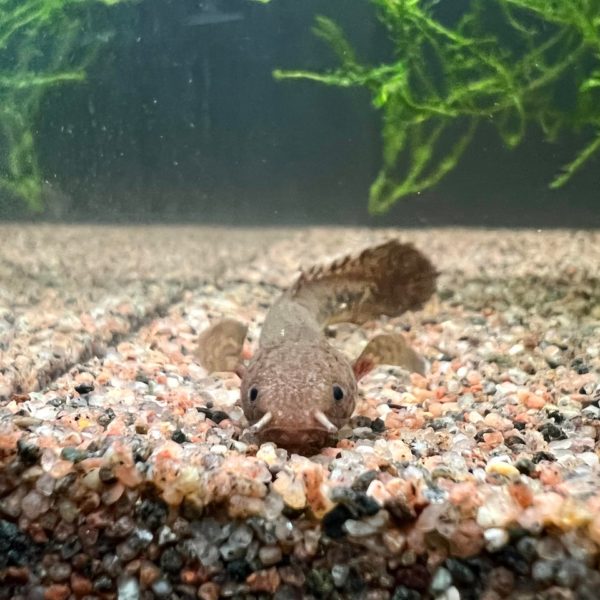
Here below are some important tips for keeping the successfully in a tank:
- Please ensure that No products found. to prevent the fish from jumping out of the tank. It is notoriously known to jump out of even large tanks.
- The tank water pH should be 7 and for the water hardness or softness the fish will just thrive in both.
- You can use a variety of tank decorations which may include rocks and aquatic plants. The rocks will provide cave-like structures where the fish can hide.
- Bichir is a bottom dweller and feeder therefore the substrate should be chosen with care. A great choice can be a thin layer of sand that will be easy to clean when need arises although you can as well use small-grained gravel.
- As you choose the stones to use for decoration in the tank, it is best to choose those that are smooth. You can also use ceramics although these will not give a natural look that impresses so many people.
- For filtration purposes it is best to installation a powerful canister filter that will be capable of use both biological and mechanical filtration. This filter will help with keeping the water clean from the protein leftovers that can quickly make the water highly toxic for the fish.
Feeding Bichir
Bichir is a predatory fish that should be fed on live foods which include; bloodworms, calamari, frozen shrimp, meat, and earthworm. You can as well give the fish artificial food such as fish flakes and pellet food but it must be noted that his kind of food is not natural for the fish.
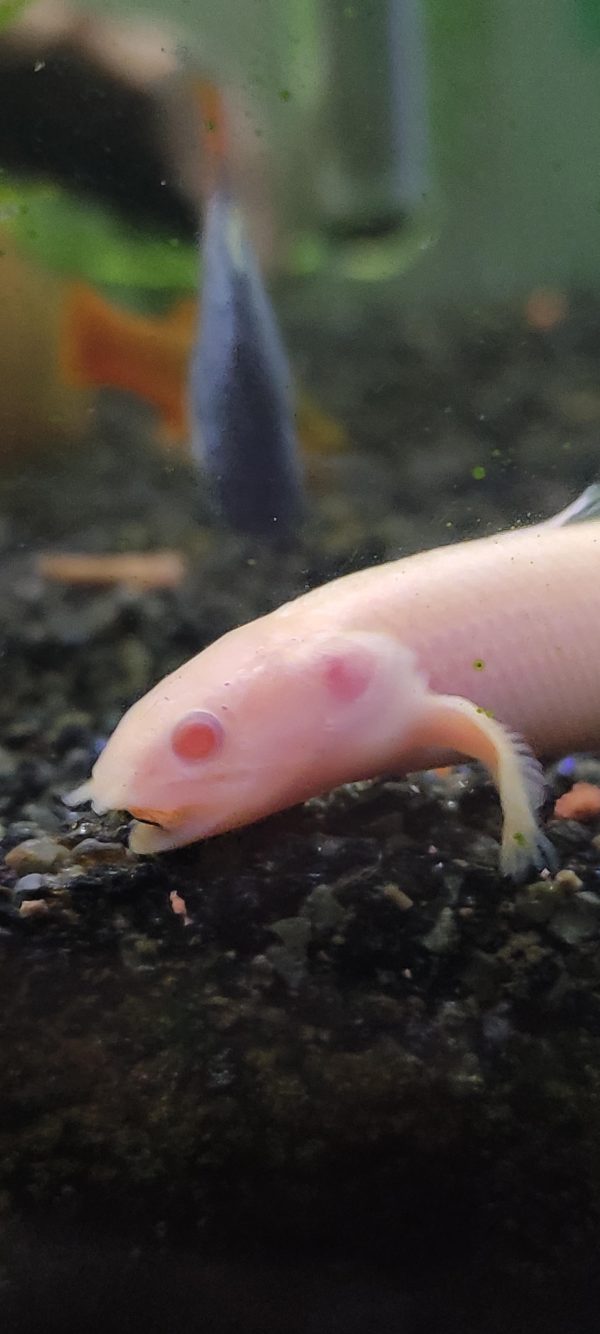
It is a slow feeder that will require lots of patience from the person that is offering food to it. It is best to lower in small portions of food in the tank and wait for the fish to feed before offering more food. This will help to ensure that fish doesn’t leave much food that will serve as a leftover to make the tank water toxic.
Compatibility with other fish in the tank
The fish will live well with many other fish species so long as the fish you put in there are large enough not to be easily consumed by it. Bichir is not known to attack large fish that are not aggressive to them.
Finding a perfect compatible tank mate for your Bichirs is all about considering the aggression and size of your fish. As discussed earlier, they are carnivores and can become very aggressive. That suggests any fish species smaller or their size will not be a good option. You, Bichir, can eat them. You should go for the fish that are a little bigger than the Bichir while looking for tank mates. Because they will not be confused with food, they can bully them. Some of the best tankmates are:
You should also ensure that the tankmates allow some foods to reach the tank’s bottom part. If this is the case, the Bichirs will become underfed and start developing different health issues.
It may be noted that you can keep two Bichirs in one tank. Well, most aquarists don’t prefer to do that; you can give this a try. But remember that the tank size should be large enough to accommodate two fully-grown Bichirs.
Sexing
There isn’t quite a distinctive difference of the sexes although there are some slight differences. The males have wider and thicker anal and dorsal fins but the females are generally wider in their genera size.
Breeding Bichir
Bichir is quite difficult to breed in the home aquarium and most of the fish you find in pet shops were most probably captured in the wild and put in tanks for sale. There is no categorical explanation of the process of breeding the fish in home aquariums because most aquarists who have attempted this have had little success if any. This, therefore, means that if you need to have more of them you may need to get one from the pet store.
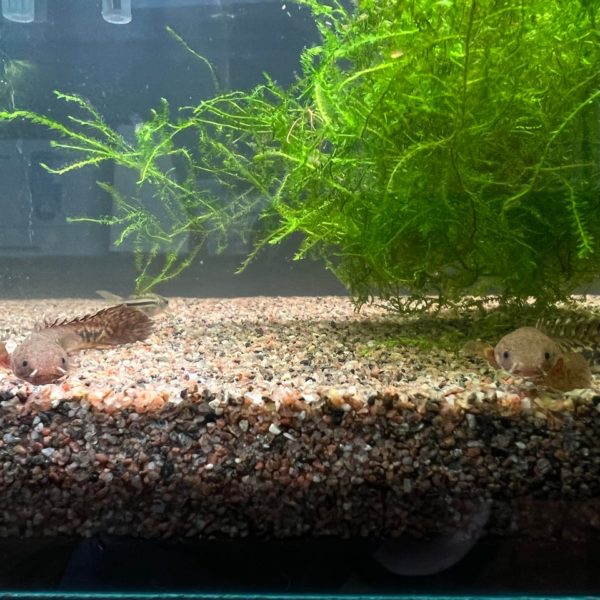
Every type of Bichir requires different water conditions and tanks for breeding. But it is still not well-understood. This may suggest you will have to do some experiments to attain success in this.
If you search online about Bichir breeding, most results are focused on Senegal Bichir. Why? They respond and perform well in cold water, which triggers their breeding. As a result, the success rate will be higher than other Bichirs types.
Some experts suggest using a perfect combination of soft and little acidic water. Besides, you should increase their overall protein intake level during their breeding.
The male Bichir generally pursues the female Bichir and headbutt her. This process can sometimes last for two to three days. Once done, the female Bichirs will find a place to lay the eggs. They generally choose bushy plants. So, don’t forget to add such plants to the tank.
Once the breeding process is done, you will have to remove them from the tank and feed the fry. To help them grow faster, you can offer them micro-worms and brine shrimp.
Conditioning Your Bichirs For Spawning
They don’t generally breed in captivity except in large ponds in tropical areas. They rarely breed in the tank as they prefer some changes in the climate, like weedy marsh plants, cool spells, and more. As most of them are wild-caught, they sometimes fail to reproduce. However, there are certain things that you can follow to make your aquarium a perfect breeding place.
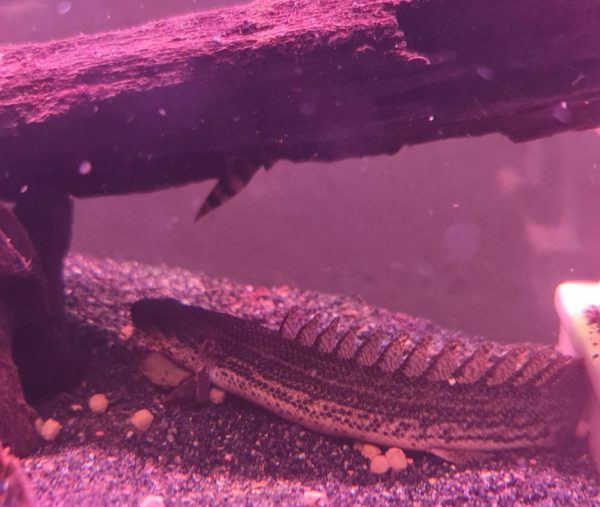
Provide Them With A Diverse Diet
Condition the Bichirs to start breeding gametes by reducing prepared food and offering them good quality frozen and live food.
Lower The Temperature
A constant drop in temperature and water change will make them feel that the season changes. So, you need to bring the temperature down to around 70-degree to 75-degree F.
Add Thick Plants
They like thick plant beds where they can scatter their eggs after fertilization. So, use such plants. You can use Guppy Grass and Java Moss as they are easy to find and grow.
Are Bichirs Good For Your Fish Tank?
As per the experts, no matter what types of Bichir you choose, they are old-looking species and can make a beautiful addition to your aquarium. Some even consider them as living fossils, and they can easily adapt to any living environment.
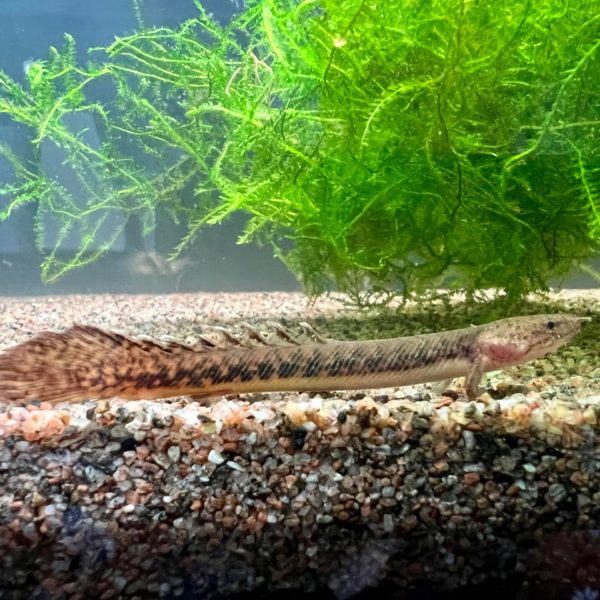
Bichirs are not suitable for beginners as they require a great level of care like other large fish. As mentioned above, Bichirs are hardy and nocturnal animals. If you can take good care of them and offer them proper living conditions, they can live for more than 20 years. So, if you think you know everything about this amazing creature and can offer them proper care, then you can go for Bichirs.
Bichir Health And diseases
Bichirs are considered robust fish, and they generally don’t develop many health issues like other species.
But they are easily susceptible to different types of parasites, for example, flukes like Macro Gyrodactylus polyptery. They have a threadlike structure, and you can see them attached to the skin of your Bichir. These parasites can develop irritation, and due to that, your Bichir will start rubbing the body against the wall substrate and begin rolling around to remove the parasites from the gills and skin. If you see such a condition, you should start the treatment as soon as possible. Most of all, the flukes can be eliminated using over-the-counter medications, and you can easily get them from any good fish stores as well as online.
It is believed that in a captive condition, the average lifespan of a Bichir is around 15 years. But by offering good care and treating the health issues immediately, you can allow them to survive up to 20 years.
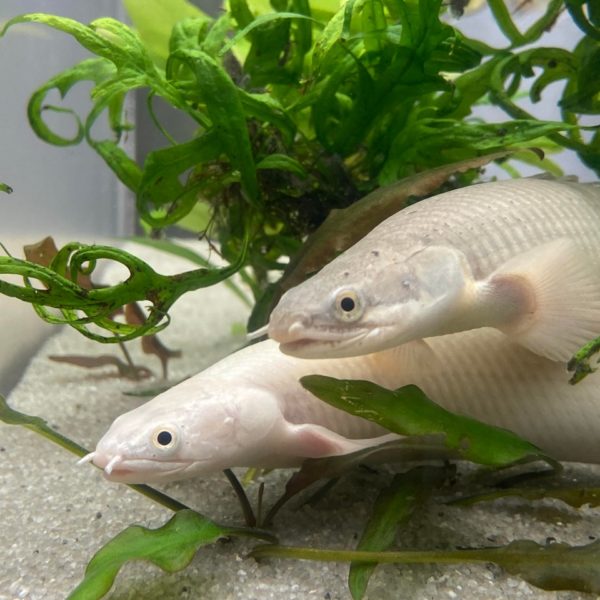
Tapeworms In Bichirs
Tapeworms are quite common among the wild-caught Bichirs. Generally, they lay eggs in the intestines of the fish. Then the eggs are moved out from the body in the waste and then eaten by invertebrates or crustaceans or invertebrates. After that, the Bichirs eat the new host, ingesting the tapeworms.
So, to make sure that your new Bichirs don’t pass those parasites to the other species living in your aquarium, you should quarantine them first into a separate tank for one month and notice their behavior. If everything is good, you can move the Bichirs to the tank. Besides, you can try to treat your Bichirs for parasitic infections while keeping them in quarantine to kill any parasites that may be lurking undetected.
FAQs
Are Bichirs Difficult To Keep In A Tank?
After going through the information mentioned in this article, it can be said that Bichirs are not that difficult to care for. But you should keep the care tips mentioned here in mind. On the positive side, Bichirs are hardy fish, and they can live in different water parameters.
Is It Compulsory To Use An Air Pump For Bichir?
Well, every fish needs fresh air to breathe. So, if there is not much water movement area in your aquarium, you will have to use an air pump if you want to keep a Bichir. Lack of air can create a stressful environment, and they will start developing different health issues.
Do They Need Light?
As per the experts, Bichirs’ eyesight is very poor, and they prefer to live in a dimly-lit area and use their sense of smell to locate food. If you are planning to use lights, you can use some plants that will diffuse the light and create a good condition for these ancient creatures.
How Do They Mate?
The females deposit around 200 to 300 eggs in several days. All the eggs are fertilized by the male Bichirs, and they cup the caudal and anal fin near the females’ genital area to collect the eggs.
What Can You Feed A Bichir?
You should use a pellet that can easily sink to the bottom so that they can easily eat them. You can feed them frozen, freeze-dried, or flake foods. If you feed prepared diets, they will show a lower predatory behavior.
Conclusion
There is no doubt that keeping Bichirs is rewarding and fun. They are like living fossils and are a great treat to watch. Their prehistoric look will surely amaze you. These species are very active compared to other bottom-feeder species. And you can also find them visiting the tank’s surface for oxygen.
The care routine for Bichir is very simple and straightforward. All you need to do is keep your bichirs in the right environment and regularly monitor the water condition.
The manageable difficulty level of care and their near appearance are the things that make them good freshwater fish. So, if you have a good size tank and all the required information, go on and bring your home a Bichir now.
